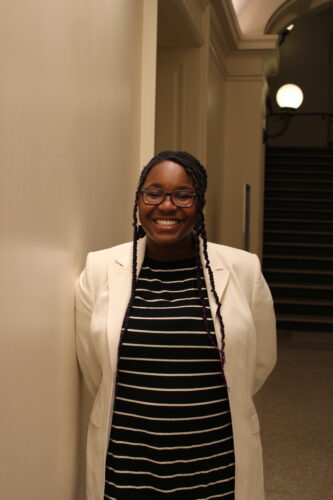Photography by Hannah Han
A double major in Classical Civilizations and Molecular Biophysics and Biochemistry, Charnice Hoegnifioh (BF ’24) is studying the science behind ancient makeup and skincare artifacts. Hoegnifioh was recently awarded the Edward A. Bouchet Fellowship and the $35,000 Beinecke Scholarship, which will support her academic research and post-graduate studies in the medical humanities, respectively.
Hoegnifioh fell in love with biochemistry in high school. She especially enjoyed conducting experiments involving spectroscopy, the study of the emission and absorption of electromagnetic radiation by matter. After participating in the MIT Introduction to Technology, Engineering, and Science program in high school, she realized that she wanted to devote her undergraduate studies to biophysics. At the same time, she loved Latin, and her passion for Classics was cemented by a school trip to Greece. Ultimately, she found that “following her passion” at Yale meant loading up on five credits of Classical Civilization courses in her first year, while also researching ultrafast protein folding in the Davis Lab. She decided to pursue a double major and focus her time on honing her skills in these two areas.
One of Hoegnifioh’s most recent classes applied spectroscopy and isotopic dating—the analysis of materials based on the decay rates of unstable elemental isotopes—to examine seals from the ancient Near East. Traditionally, these seals, which were ubiquitous in Mesopotamia and used for administrative and decorative purposes, were dated based on their iconography since their styles could be traced back in time. Hoegnifioh explained that studying the seals’ isotopic proportions can allow researchers to determine their geographical origins. “By looking at isotopic ratios of materials, you can differentiate whether a material or mineral came from Scandinavia or the Middle East,” Hoegnifioh said.
As an Edward A. Bouchet Fellow, Hoegnifioh will study abroad in Germany, Greece, Italy, the United Kingdom, and France this summer and visit archaeological sites to research ancient cosmetic artifacts and their effects on healing. One artifact she’s particularly excited to see is an ointment tin from ancient Rome, excavated by the Museum of London twenty years ago, that still shows the preserved fingerprints of the original owner. Beyond the Museum of London, Hoegnifioh will go to the archeological museum in Frankfurt to view their exhibition of paint pots. “[Cosmetics] were posited as healing outward feminine flaws but also inward flaws in women. So I’ll be going to some healing sanctuaries and learning more about healing authority and what ingredients were thought [to have] curative properties,” Hoegnifioh said.
Her work will culminate in her senior thesis, tentatively titled “Remedies for Roman Beauty: Curative Cosmetics during the Roman Empire.” Hoegnifioh’s interest in cosmetics began during her summer internship at Harvard, where she conducted a research project on the painful and poisonous aspects of beauty as a first-year student. Through her research, she learned that one of the most popular misconceptions about beauty routines in the classical world is that the ancient Romans unknowingly used lead within the cosmetic pigment. “It turns out that the Romans were actually aware that white lead was extremely toxic, as there was a treatise written that lead shouldn’t be used in pipes or buildings because it will lead to poisoning. But women were still being hurt, so I wanted to investigate why these societal standards were coming before women’s health,” Hoegnifioh said.
Hoegnifioh cites multiple major influences in her journey throughout Yale, the first being her Latin professor from her first year, Irene Peirano Garrison, who left Yale to teach at Harvard but remained her close confidant and advisor. Peirano Garrison advised Hoegnifioh to pursue a Ph.D. in the humanities and guided her through an ongoing graduate project on makeup in antiquity. “Her impact on my life is beyond words. I would not be where I am without her and her motivational presence in my life,” Hoegnifioh said. She also cites Jessica Lamont, an assistant professor of Classics, and Milette Gaifman, the Andrew Downey Orrick Professor of Classics and History of Art, as other advisors who have guided her through her undergraduate studies.
When asked what advice she would give to underclassmen, Hoegnifioh emphasized that double majoring in two disparate fields is achievable given proper preparation, and she hopes that no one is deterred because of the prerequisite courses. “Planning is key, but don’t hold yourself to super strict standards because things change. So allow yourself that flexibility,” Hoegnifioh said. “Remember that imposter syndrome is real, but you are talented, and if you’re at Yale, you definitely deserve to be here.”

